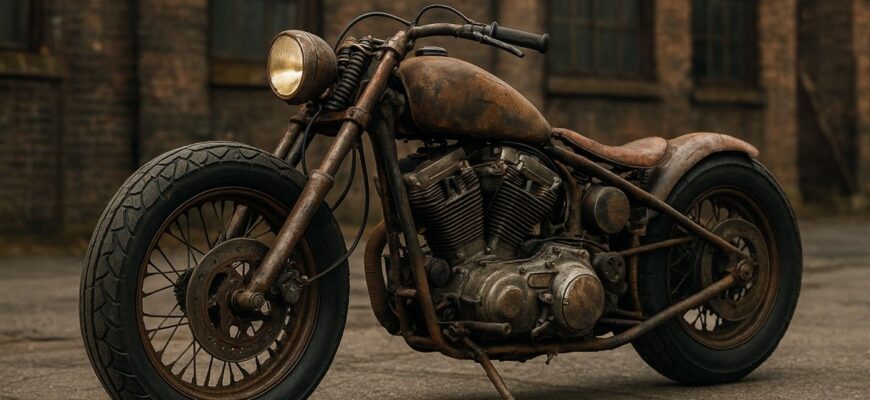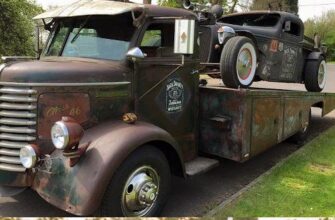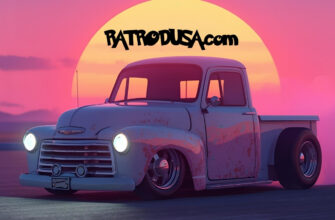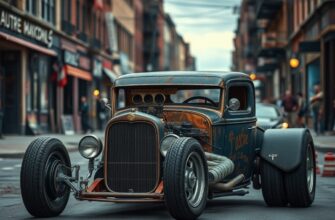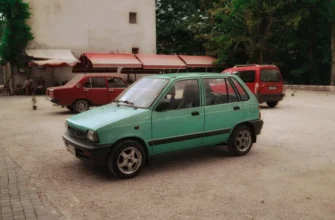Discover the gritty world of Rat Rod Motorcycles. From their history to unique designs, learn what makes these vintage bikes a true counter-culture statement.
The Gritty Soul of the Road: Why We Love Rat Rod Motorcycles
There’s a certain kind of beauty in imperfection. While some riders obsess over polished chrome, perfect paint, and the latest technology, others find their passion in a different kind of machine: the Rat Rod motorcycle. These aren’t your typical show bikes. They’re raw, a little rough around the edges, and utterly authentic. They tell a story of a different era, a time when a rider’s personal style was built, not bought. If you’ve ever seen one of these on the road, you know they command attention. They’re a testament to creativity, resourcefulness, and a rebellious spirit that scoffs at convention.
I’ve been a motorcycle enthusiast for as long as I can remember, and I’ve seen my share of bikes. But the first time I saw a real-deal Rat Rod up close, it was like seeing a piece of history that was still alive. It was at a local bike show, tucked away from the gleaming custom choppers. This bike was rusty, its paint was faded and peeling, and parts looked like they were salvaged from a junkyard. And yet, it was the most beautiful thing there. The owner told me it was a labor of love, a true rolling art piece. That’s when I truly understood the philosophy behind these incredible machines.
This article isn’t just a list of facts; it’s a deep dive into the culture and passion that fuels the Rat Rod movement. We’ll explore their unique history, the design elements that define them, and what it’s like to actually own and ride one of these vintage masterpieces.
The History of Hot Rods on Two Wheels
To understand Rat Rod motorcycles, you first have to look at their four-wheeled cousins: the hot rods. The original hot rod culture grew out of post-war America, where returning soldiers and young car enthusiasts were looking for cheap, fast thrills. They stripped down old Fords and Chevys, souped up the engines, and raced them on dry lake beds. The term “rat rod” emerged later as a counter-culture to the overly expensive, “perfect” hot rod show cars of the 1980s and 90s. While show cars were all about flawless paint jobs and chrome, the Rat Rod movement celebrated the opposite: rust, patina, and raw, unfinished aesthetics.
This same spirit of rebellion and resourcefulness quickly translated to two wheels. Builders began applying the same principles to motorcycles. Instead of spending thousands on new parts and paint, they would scour junkyards, swap meets, and even local barns for old motorcycle frames, engines, and parts. The goal was never to create a perfect bike, but a functional, unique, and deeply personal one. A true custom Rat Rod is a testament to the builder’s vision, not their wallet.
Anatomy of a Rat Rod Bike: Embracing Imperfection
What makes a bike a Rat Rod bike? It’s more of a philosophy than a rigid set of rules, but there are some common design elements you’ll often see.
- The Patina is the Point: The most defining feature is the intentional use of rust and a weathered, aged appearance. This isn’t just neglect; it’s a careful preservation of the bike’s history. Instead of repainting a tank, a builder might clear-coat the existing rust to preserve the raw texture. It’s about celebrating the bike’s past life.
- Alt text idea: A close-up shot of a rusted motorcycle gas tank with a clear coat, showing the texture and color variations of the patina.
- Salvaged and Reclaimed Parts: You’ll rarely find a Rat Rod with a catalog full of brand-new parts. Builders pride themselves on using parts from different bikes, cars, and even household objects. An old wrench might become a shifter, a license plate could be a fender, and a rusty bucket might be fashioned into a headlight housing. This “Frankenstein” approach gives each bike its own unique personality.
- Alt text idea: A detail shot of a Rat Rod’s rear fender made from a repurposed metal plate with a license plate bolted on.
- Bare Bones Functionality: Everything on a Rat Rod serves a purpose. There’s no room for unnecessary frills. Fenders might be minimal or non-existent, wiring is often exposed, and seats are usually custom-made from repurposed materials, sometimes even an old tractor seat or a piece of wood. The focus is on the raw mechanics and the sheer joy of riding.
- Mix-and-Match Engines: It’s not uncommon to see an engine from one type of bike or car engine in a completely different frame. A Harley-Davidson engine in a British Triumph frame? A V-8 engine in a custom chopper frame? Yes, these aren’t just fantasy; they’re the kind of projects that define the hot rod motorcycles subculture. The goal is always performance and a unique build, not brand loyalty.
- Rider-Built, Not Mass-Produced: The most important rule of all is that the bike must be a genuine, hands-on build. A professional shop might do some of the work, but the final vision and most of the fabrication are from the hands of the owner. This is what makes a Rat Rod a personal statement.
The Art of the Build: Tips for Your Own Rat Rod Project
If you’re inspired to build your own Rat Rod, remember that the journey is as important as the destination. Here are a few tips to get you started on your very own vintage motorcycle project.

- Start with a Solid Foundation: Don’t just grab the first rusty frame you see. The frame itself needs to be structurally sound. Look for an old Harley, Honda, or even a pre-war Indian frame. Check for cracks and ensure the geometry is straight before you begin.
- Scavenge, Don’t Shop: Your local junk shop, flea market, and online classifieds will be your best friends. Keep an eye out for old car parts, rusty tools, and anything that can be repurposed. You’ll be surprised what you can find and how it can be integrated into your bike.
- Embrace the Rust: Learning to manage and preserve rust is key. A light sand and a clear coat can stop rust from eating through the metal while keeping that authentic, weathered look. A little rust converter can also work wonders on more aggressive spots.
- Function Over Form: Every decision you make should be about making the bike rideable and safe. Sure, a giant old headlight looks cool, but if it doesn’t provide enough light, it’s a liability. Focus on getting the engine running, the brakes working, and the lights lit before you start on the cosmetic stuff.
- Seek Inspiration, Not Duplication: Look at other Rat Rods for inspiration, but don’t try to copy them. Your bike should be a reflection of your own style and personality. The best builds are those that are truly unique. For more inspiration, check out sites like BikeEXIF or forums like The Jockey Journal.
- Internal Link suggestion: See our guide to custom motorcycles for more in-depth building tips and techniques.
FAQs About Rat Rod Motorcycles
Q1: Are Rat Rod motorcycles street legal? A: Yes, as long as they meet the legal requirements for a motorcycle in your state or country. This typically includes working brakes, headlights, taillights, turn signals, and a license plate. While the bike might look unconventional, the same road safety rules apply.
Q2: How do you maintain a rusty motorcycle? A: The key is to manage the rust, not eliminate it. You can use clear coat or specialized rust sealants to preserve the patina and prevent further corrosion. The mechanical parts, like the engine, chain, and brakes, should be maintained just like any other motorcycle, with regular oil changes and inspections.
Q3: Is a Rat Rod cheaper to build than a traditional custom bike? A: Not always. While a Rat Rod uses salvaged and reclaimed parts, the labor involved in custom fabrication can be extensive. The cost depends entirely on the parts you find and your ability to do the work yourself. However, the initial investment for parts can be significantly lower than buying new, high-end components.
Q4: What’s the difference between a Rat Rod and a “Junk Bike”? A: The main difference is intent. A “junk bike” is often just a neglected, poorly maintained motorcycle. A true Rat Rod, on the other hand, is a deliberate artistic and functional statement. Every piece is carefully chosen and integrated, even if it looks like it came from a junkyard. It’s the difference between an accidental mess and a meticulously crafted piece of art.
Q5: Where can I find parts for my Rat Rod project? A: The best places are local flea markets, swap meets, junkyards, and online marketplaces like Craigslist and eBay. Motorcycle-specific forums and online communities can also be a great resource for finding vintage parts and connecting with other builders.
The Ride: More Than Just a Bike
Riding a Rat Rod is an experience unlike any other. You’re not just on a machine; you’re on a rolling piece of art and history. The sound of the engine, the feeling of the road, and the looks you get from people—it all adds up to a unique connection between rider and machine. This isn’t a bike for the faint of heart; it’s for someone who appreciates the raw, unfiltered experience of riding.
Owning a Rat Rod motorcycle is about embracing authenticity and rejecting the cookie-cutter world of mass-produced bikes. It’s a bold statement that says, “I built this. This is me.”
What’s your Rat Rod story? Have you built one, or are you dreaming of your next project? Share your thoughts and experiences in the comments below. We’d love to hear about your unique ride!
Sources:
- Jockey Journal Forum: A great resource for custom motorcycle builders and enthusiasts.
- Bike EXIF: Features high-quality photos and detailed stories of custom bikes, including Rat Rods.
- Cycle World Magazine: A long-standing authority on motorcycles, often covering unique builds and vintage projects.
(5)

